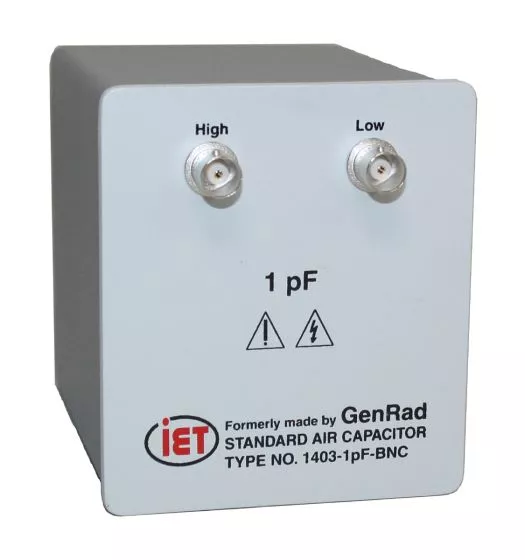
High Frequency Standard Capacitor
- Available in values from 0.001 pF - 1000 pF
- Excellent performance at high frequencies
- ISO-17025 accredited calibration included with the standard
- NEW 1403-1pF-BNC and 1403-0.001pF-BNC versions
The IET Labs/GenRad 1403 Standard Air Capacitors are stable, The IET Labs/GenRad 1403 Standard Air Capacitors are stable, three-terminal standards in values from 0.005 pF to 1000 pF.
The capacitance change is less than 0.01% at frequencies up to 2 MHz for 1 pF and 200 kHz for 1000 pF standard making the standard ideal for verifying LCR meters and bridges at frequencies other than 1 kHz.
Their terminals are arranged to plug directly into the UNKNOWN terminals of the Type 1620 Capacitance Bridge or equivalent such as AH2500A Ultra Precision Capacitance Bridge. The GenRad/IET Labs 1403s traditionally have been manufactured with GR 0874 connectors. Newer 1403-BNC versions are now available with BNC connectors for easy connection to a wide variety of LCR Meters and bridges.
Features of the 1403 Air Capacitor:
- Stable to better than 0.05%/year
- Excellent performance at high frequencies
- Extremely low dissipation factor
- Low temperature coefficient
- Well documented performance by nationally recognized laboratories
Design
The Types 1403-A, 1403-D, and 1403-G have nominal values of 1000 pF, 100 pF, and 10 pF, respectively. Their construction follows a conventional design, similar to that of the 1404 Series of Capacitance Standards, consisting of interleaved stacks of aluminum plates rather than the invar plates used in the 1404 Series. Each plate is insulated from the supporting panel and housing.
The stacked plate construction is not practical for values of 1 pF and below, so an aperture design is used. In this type of capacitor, the two electrodes are isolated from each other by a guard plate between them. The shielding provided by this plate is designed to minimize stray capacitance between the active electrodes to nearly zero.
The magnitude of capacitance between the electrodes is determined by the opening (aperture) in the guard plate along with the spacing between the two electrodes.
The effective area of the aperture is slightly smaller than what would be determined by its diameter. This reduction in effective area can be described as “negative fringing” of the electric field.
Since there is no solid dielectric in the direct capacitance field, the losses in the 1403 capacitors are extremely low, typically < 20 ppm (unitless).

Figure 1. Aperture design on the left and the other 2 are conventional stacked plates
All 1403s have shielded terminals, both of which are connected to the case.
For measurements at 100 pF and below, a three-terminal connection increases accuracy by eliminating uncertainty introduced by the capacitance between the capacitor terminals and ground. This improves the performance of the capacitor when used with LCR meters.
The 1403 Standard Air Capacitors have been extensively studied. The performance over frequency, barometric pressure and temperature have been well-documented, by articles such as the two shown below.
The paper The Measurement and Uncertainty of Air Dielectric Capacitors from 1 kHz to 10 MHz provides extremely useful information on the change of capacitance vs barometric pressure, relative humidity and temperature for the 1403 Series Air Capacitors.
The paper Establishment of 2TP air-dielectric capacitance standard for 1 pF, 10 pF, 100 pF and 1000 pF in the frequency range up to 10 MHz by resonance frequency at NIMT provides information on calibration of 1403 Series Air Capacitors at up to 1 MHz for use in calibrating LCR meters.
IET Labs calibrates the 1403s at it's facility in West Roxbury, MA. The approximate elevation is 115 feet (35 meters) above sea level. Given this elevation the approximate air pressure is 101000 Pa.

